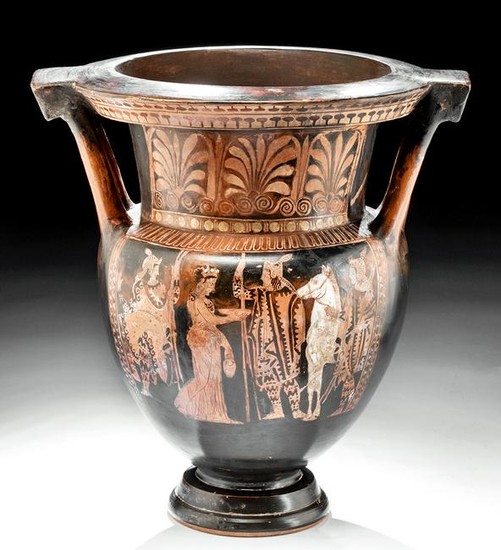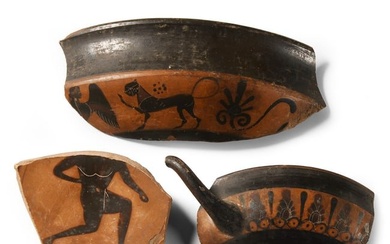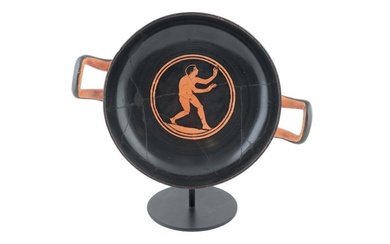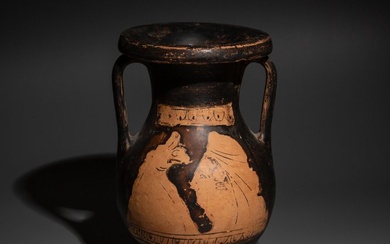Greek Attic Red-Figure Column Krater, Suessula Painter
Ancient Greece, Athens (Attic), ca. 410 to 400 BCE. In a word, BREATHTAKING!!! This sizeable red-figure krater was created by the Suessula Painter. The vessel body depicts a departure scene with three Thracian warriors dressed in opulent Eastern costumes, a white horse between the two at the right, and a woman wearing a chiton and holding an oinochoe and a phiale towards the central figure. The Suessula Painter created marvelous figures, rendering the details of their dress and accoutrements as well as their poses with virtuosity. On the verso of this vessel are three cloaked youths engaged in conversation. In addition to this wonderful figural iconography, the decorative program is quite impressive and extensive; do take note of the Suessula Painter's signature stylized lotus buds on one side of the neck and the unusual T and Y shaped ivy leaves framing the panels and adorning the rim underside, motifs that occur "nowhere else but on column-kraters by the Suessula Painter" according to scholar J. Michael Padgett. Furthermore, fugitive white pigment embellishes the horse as well as the the female's diadem, the warrior's helmets, and elements of the decorative program. Size: 13.25" W x 13.875" H (33.7 cm x 35.2 cm)
This vase was attributed to the Suessula Painter by J. Michael Padgett, Curator of Ancient Art at the Princeton University Art Museum since 1992, in his article entitled, "Whom are You Calling a Barbarian?" A Column Karter by the Suessula Painter" in "Athenian Potters and Painters Volume III" edited by John H. Oakley (Oxbow Books 2014, p. 149). Padgett's extensive analysis of the Suessula Painter's signature style and motifs is quite applicable when viewing this vessel.
John Beazley dubbed The Painter de Suessula after a site in Campania, Southern Italy where a significant number of the artist's works were found. Scholars believe that The Painter de Suessula is most likely of Corinthian origin. He worked in Corinth as well as Athens. Attic vases that were exported to Italy provided great inspiration for artists during the 4th century BCE.
Perhaps the most exciting innovation in Greek vase painting was the red-figure technique, invented in Athens around 525 BCE and beloved by other artists of Magna Graecia. The red-figure technique allowed for much greater flexibility as opposed to the black-figure technique, for now the artist could use a soft, pliable brush rather than a rigid metal graver to delineate interior details, play with the thickness of the lines, as well as build up or dilute glazes to create chromatic effects. The painter would create figures by outlining them in the natural red of the vase, and then enrich these figural forms with black lines to suggest volume, at times perspectival depth, and movement, bringing those silhouettes and their environs to life. Beyond this, fugitive pigments made it possible for the artist to create additional layers of interest and detail as we see in this example.
For parallel rendering of horses by the Painter de Suessula see an Attic red-figure neck amphora at the Louvre (Collection Challet, 1875, 1875 - The Milo Amphora - MNB 810). In addition, see three vessels attributed to the Suessula Painter at the Metropolitan Museum of Art (44.11.12; 44.11.13; 17.46.1; ).
Provenance: ex-English collection, acquired in the 1960s; acquired by current owner at Paris art market in 2007
All items legal to buy/sell under U.S. Statute covering cultural patrimony Code 2600, CHAPTER 14, and are guaranteed to be as described or your money back.
A Certificate of Authenticity will accompany all winning bids.
We ship worldwide to most countries and handle all shipping in-house for your convenience.
#152685 Dimensions: Condition Report: Professionally repaired from multiple pieces with restoration over the break lines, but this is very well done. The reverse (side depicting draped youths) was misfired in ancient times as shown; however, the imagery is still discernible. A fabulous example with marvelous painting technique, nice white fugitive pigment, and incredible details.
View it on
Sale price
Estimate
Time, Location
Auction House
Ancient Greece, Athens (Attic), ca. 410 to 400 BCE. In a word, BREATHTAKING!!! This sizeable red-figure krater was created by the Suessula Painter. The vessel body depicts a departure scene with three Thracian warriors dressed in opulent Eastern costumes, a white horse between the two at the right, and a woman wearing a chiton and holding an oinochoe and a phiale towards the central figure. The Suessula Painter created marvelous figures, rendering the details of their dress and accoutrements as well as their poses with virtuosity. On the verso of this vessel are three cloaked youths engaged in conversation. In addition to this wonderful figural iconography, the decorative program is quite impressive and extensive; do take note of the Suessula Painter's signature stylized lotus buds on one side of the neck and the unusual T and Y shaped ivy leaves framing the panels and adorning the rim underside, motifs that occur "nowhere else but on column-kraters by the Suessula Painter" according to scholar J. Michael Padgett. Furthermore, fugitive white pigment embellishes the horse as well as the the female's diadem, the warrior's helmets, and elements of the decorative program. Size: 13.25" W x 13.875" H (33.7 cm x 35.2 cm)
This vase was attributed to the Suessula Painter by J. Michael Padgett, Curator of Ancient Art at the Princeton University Art Museum since 1992, in his article entitled, "Whom are You Calling a Barbarian?" A Column Karter by the Suessula Painter" in "Athenian Potters and Painters Volume III" edited by John H. Oakley (Oxbow Books 2014, p. 149). Padgett's extensive analysis of the Suessula Painter's signature style and motifs is quite applicable when viewing this vessel.
John Beazley dubbed The Painter de Suessula after a site in Campania, Southern Italy where a significant number of the artist's works were found. Scholars believe that The Painter de Suessula is most likely of Corinthian origin. He worked in Corinth as well as Athens. Attic vases that were exported to Italy provided great inspiration for artists during the 4th century BCE.
Perhaps the most exciting innovation in Greek vase painting was the red-figure technique, invented in Athens around 525 BCE and beloved by other artists of Magna Graecia. The red-figure technique allowed for much greater flexibility as opposed to the black-figure technique, for now the artist could use a soft, pliable brush rather than a rigid metal graver to delineate interior details, play with the thickness of the lines, as well as build up or dilute glazes to create chromatic effects. The painter would create figures by outlining them in the natural red of the vase, and then enrich these figural forms with black lines to suggest volume, at times perspectival depth, and movement, bringing those silhouettes and their environs to life. Beyond this, fugitive pigments made it possible for the artist to create additional layers of interest and detail as we see in this example.
For parallel rendering of horses by the Painter de Suessula see an Attic red-figure neck amphora at the Louvre (Collection Challet, 1875, 1875 - The Milo Amphora - MNB 810). In addition, see three vessels attributed to the Suessula Painter at the Metropolitan Museum of Art (44.11.12; 44.11.13; 17.46.1; ).
Provenance: ex-English collection, acquired in the 1960s; acquired by current owner at Paris art market in 2007
All items legal to buy/sell under U.S. Statute covering cultural patrimony Code 2600, CHAPTER 14, and are guaranteed to be as described or your money back.
A Certificate of Authenticity will accompany all winning bids.
We ship worldwide to most countries and handle all shipping in-house for your convenience.
#152685 Dimensions: Condition Report: Professionally repaired from multiple pieces with restoration over the break lines, but this is very well done. The reverse (side depicting draped youths) was misfired in ancient times as shown; however, the imagery is still discernible. A fabulous example with marvelous painting technique, nice white fugitive pigment, and incredible details.






